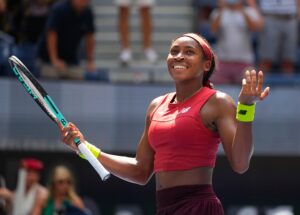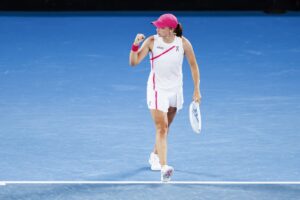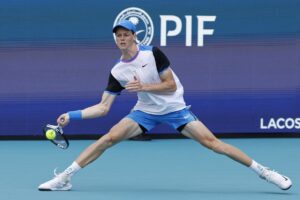This year’s Australian Open has been the tournament of comebacks. Almost everywhere you look in Melbourne, there has been a seemingly unbelievable story of a player who had been written off but finally realises (or in some cases, returns to) their true greatness. In the first week alone, Britain’s Dan Evans and Germany’s Mischa Zverev both stunned Top 10 players (in Zverev’s case, the #1 player!), but it is in the second week that things have really taken a turn for the surreal. As various people have suggested, 2017 is looking a lot like 2007, with a women’s singles final between the Williams sisters and the much-dreamed-of men’s singles final between Federer and Nadal. And if any one of Federer, Nadal or Venus becomes the Australian Champion, they will have a strong case for having made one of the greatest comebacks in tennis history, if not the greatest comeback of all. But how would they compare with the greatest comebacks in tennis history so far? Here are the top five, in ascending order.
- JIMMY CONNORS BEATING MIKAEL PERNFORS AT WIMBLEDON IN 1987
Great comebacks come in many different forms. Some (including several on this list) are career comebacks, as a player who has lost their way, to the extent that it appears their career is over, somehow fights back to win the glory that had been denied to them previously. Other great comebacks happen in the course of just one match, as a player staring defeat in the face somehow pokes defeat in the eye and scrambles their way to success. And the greatest single example of this comeback from the dead during a match is Jimmy Connors’ extraordinary victory over Sweden’s Mikael Pernfors in the fourth round at Wimbledon in 1987.
Connors’ fighting spirit was already the stuff of legend before this match but the victory over Pernfors, which is often described as the greatest ever comeback in Wimbledon history, cemented it. Connors had basically been thrashed for the first two sets and most of the third, as Pernfors, a marvelously talented player who is often forgotten because of the greatness of his fellow Swedes (notably Stefan Edberg and Mats Wilander) in the 1980s, demonstrated his full repertoire of astounding shots. Pernfors led 6-1, 6-1 and 4-1 in the third set when the tables completely turned. As if embarrassed by the scale of the defeat he was facing, Connors suddenly found his form and, inspired by a Centre Court crowd cheering him to the rafters, he fought back from a seemingly inevitable loss to win in five sets, 1-6, 1-6, 7-5, 6-4, 6-2. Although Connors eventually succumbed in the semifinals to Pat Cash, who went on to win the title that year, the match against Pernfors seemed to revitalize him completely, to the extent that four years later, at the age of 39, he reached another Slam semifinal at the US Open.
- JANA NOVOTNA WINNING WIMBLEDON IN 1998 (AFTER THROWING IT AWAY IN 1993)
In 1993, Jana Novotna did a Connors in reverse, as she threw away victory in the Wimbledon final when she seemed to have one hand and four fingers on the Venus Rosewater Dish. After defeating her fellow Czech serve-and-volleyer, Martina Navratilova, in the semifinal, she led another true great of the game, Steffi Graf, 4-1 in the third set and was within a point of an apparently unassailable 5-1 lead when she double-faulted. What followed has often been described as the “worst choke ever,” not only in tennis but in all of sport, as Graf won the next five games in a row to take the title, leaving a shattered Novotna sobbing on the shoulder of the Duchess of Kent after she had accepted her runner-up prize.
It was widely feared that Novotna would never recover from that loss. Indeed, that was nearly the case as she took four long years to reach another Wimbledon final, but once again she lost, as another great, Martina Hingis, became the youngest ever Wimbledon women’s champion at just 17. However, Novotna made it “third time lucky” in 1998, when she finally won Wimbledon by beating France’s Nathalie Tauziat in straight sets. Novotna was certainly fortunate not to face another all-time great in that final, but she had already avenged her loss to Hingis the previous year by beating her in the semifinal. In any case, in the final she conquered the greatest opponent that anyone can ever face – themselves (and their demons).
- KIM CLIJSTERS’ CAREER COMEBACK
Kim Clijsters would undoubtedly have been the greatest ever Belgian tennis player (male or female) if she had not had the misfortune to play at the same time as her even more illustrious compatriot, Justine Henin. In the first half of her career, Clijsters not only came up against the Williams sisters at the absolute peak of their powers but, if she managed to win past either or both of them, she usually found Henin waiting for her in the final. In total, she lost three Major finals to her compatriot in 2003 and 2004. Consequently, when Clijsters finally won a Grand Slam in 2005 (defeating Mary Pierce in the US Open final), it seemed that she had finally attained the Major success she had been chasing all her life and she retired from the game not long after, so she could start a family.
However, even the joy of motherhood could not sate Clijsters’ desire for more Grand Slam glory. So, after giving birth to her first child, she returned to tennis in 2009. In a precursor to Roger Federer’s run to this year’s Australian Open final after six months out through injury, Clijsters won her second US Open title in what was only her third post-retirement tournament and in the process became the first woman Wild Card entrant to win the US Open. Astonishingly, Clijsters did not stop there, as she completely transformed her career in its second half. Having seemingly been the perpetual runner-up to Henin and the Williams sisters in the early 2000s, after returning from retirement she went on to win two more Grand Slam titles, retaining the US Open in 2010 and then winning the very next Slam, the 2011 Australian Open. She retired again, for the second and final time, in 2012, as the proud winner of four Major titles. Given her early efforts to break through, at one point that would have seemed utterly unthinkable.
- JENNIFER CAPRIATI’S EVEN GREATER CAREER COMEBACK
At least Clijsters only had to come back from the disappointment of losing a succession of Grand Slam finals. Jennifer Capriati’s career comeback was even greater, as she had suffered an ignominious fall of the kind that few sportsmen or women (indeed, few people of any kind) ever have to endure. Having been a genuine “golden girl” (she turned professional in 1990 before she was even 14), Capriati failed to capitalize on her undoubted ability and eventually “retired” from tennis (or at least, dropped out of the game) at the preposterously early age of 18. Her fall from grace was complete when she was arrested for shoplifting and possession of marijuana. The former “poster girl” of tennis duly became the most famous “mugshot” in the world.
Like Clijsters and Novotna, and indeed like Mirjana Lucic-Baroni, who endured her own years of personal struggle before reaching the semifinal at the Australian Open this year, the road back for Capriati was long and at times torturous. Indeed, for several years after her return to tennis she seemed only capable of being, at best, a “journeywoman,” who was nowhere near fulfilling the incredible potential of her youth. Then a new millennium brought a new Capriati, as she finally won the Majors that she had always seemed destined to win. Indeed, in 2001 she won the first two Majors of the year – the Australian Open and the French Open – and for a few weeks there was even talk of her achieving a calendar Grand Slam, before she lost to Justine Henin in the Wimbledon semifinal. Nevertheless, this was still a vast improvement on her record during her “wilderness” years and for good measure she retained her Australian Open title in 2002. When she finally retired, for good, in 2004, she did so knowing that she had achieved one of the greatest turnarounds in their career that any tennis player has ever enjoyed.
- GORAN IVANISEVIC FINALLY WINNING WIMBLEDON IN 2001
It is hard to think of a more universally acclaimed Major win than that of Goran Ivanisevic’s Wimbledon victory in 2001. Ivanisevic had already lost three Wimbledon finals to the two great American players of his era – Andre Agassi (in 1992) and Pete Sampras (in both 1994 and 1998) – and after that third defeat, in five sets, he seemed to lose his way and, even more importantly, his motivation. He plunged down the world rankings, to the extent that he had to be granted a Wild Card just to enter Wimbledon in 2001.
The fact that he went on to win Wimbledon as a Wild Card, the only man ever to do so, was just the most astonishing of Goran’s many astonishing feats that year. First, he beat a series of fine players, including Marat Safin (who at that time was the reigning US Open Champion), to make the semifinal. Then he broke British hearts by defeating home favorite Tim Henman in an extraordinarily elongated semifinal; rain delays meant it unfolded over three days, necessitating a Men’s singles final on a Monday against Australia’s Pat Rafter. In a genuinely classic final, which was probably the greatest men’s final between the twin peaks of Borg-McEnroe in 1980 and Federer-Nadal in 2008, Ivanisevic eventually won 9-7 in the fifth set. Such was his emotional reaction to finally winning Wimbledon nearly a decade after his first final that even Rafter, a true Aussie “nice guy,” seemed genuinely pleased for him.
AND THE ULTIMATE TENNIS COMEBACK: THE RETURN OF SERVE AND VOLLEY?
The comebacks listed above are those of individual tennis players who either fought back from defeat in a single match (in the case of Jimmy Connors) or from what appeared at one point to be total career collapse. However, at the Australian Open in the past fortnight, we have seen glimpses of what might be the ultimate tennis comeback – the return of serve-volleying.
It is hard to believe now, when almost all players are essentially baseliners, but for most of tennis history the very greatest players were almost all serve-volleyers. However, the advent of generally slower courts, even at Wimbledon (the one remaining Grand Slam played on grass), and the evolution of non-wooden rackets, such that the few remaining serve-volleyers could be more easily picked off at the net, has meant that true serve-volleyers have become almost extinct. And yet in this year’s Australian Open, Mischa Zverev stunned Any Murray, the World No. 1, by rushing the net, and in his titanic semifinal against Stan Wawrinka, Roger Federer, who grew up as a serve-volleyer, returned to his original game at times, particularly in fraught moments in the final set.
If, as appears to be the case, tennis courts around the world are gradually becoming quicker again, perhaps serving and volleying can become an attractive alternative to the baseline-dominated game of the last decade. And if that happens, it will be the greatest tennis comeback of all.
Enjoy articles looking back at all-time best players and tennis history in general? Make sure to check out our page devoted to stories appreciating historic achievements in tennis.






